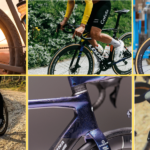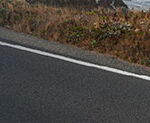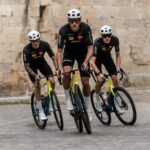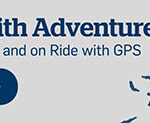What Gear Do I Need for a Week-long Tour as a Newbie?
Dear Newbie,
I have good news and bad news. The equipment you need for a week-long tour is pretty much the same as what you need for a month-long or even cross-country tour. I say it’s good news because once you’ve dialed in your kit, you’ll be ready for all sorts of bike travel adventures. Woohoo! On the other hand, sourcing that much gear may be daunting, but I know you are up to the challenge.
So where do you start? If you’ve camped, you probably already have a lot of the gear you need. Before I discovered my passion for cycling and bike travel, I was already a lover of the outdoors. I really enjoyed weekends driving to a nice spot, pitching a tent, cooking, and relaxing in nature. I had the basics, although not in any kind of lightweight form. When I started cycling, however, I didn’t personally know anyone who did self-supported bike touring. So, I decided to use the resources that I had and signed up for an eight-week backpacking class through my local Sierra Club chapter. While I enjoyed the weekend outings immensely, I always had in mind how I might apply the knowledge and skills I was learning to bike touring. Then, I slowly purchased lighter camping gear that was appropriate for both backpacking and bike touring.
Which brings me back to your question: What do you need? Unless you’re trying to go ultralight, your “sleeping system,” meaning your tent, sleeping bag, and air mattress — will be the bulk of — and your bulkiest — gear. But while size and weight matter, so does comfort.
Tent
If you already have a one- or two-person tent, and it’s in decent condition, great! Don’t worry about having a specific bikepacking tent, especially not right away.
Sleeping Bag
Every quality sleeping bag has minimum temperature ratings for both comfort and safety, so if the nighttime temps where you plan to camp are above those numbers, you should be fine. But if it’s summer and you won’t be staying in a high-elevation area, you’ll likely have some flexibility with what bag you bring. And if all you have is a super bulky, heavy bag, you might even be okay pairing a light-weight blanket with a sleeping bag liner instead to save weight and space.
Sleeping Pad
Sleeping directly on the ground can be a deal-breaker not only because it’s uncomfortable, but also because it pulls warmth from your body. Enter the air mattress. I maintain that I can sleep perfectly well on mine for weeks at a time. While you can easily spend over $200 on a packable camping air mattress (think around the size of a 1-liter Nalgene bottle), you can also get a decent one that’s slightly bigger for around $60.
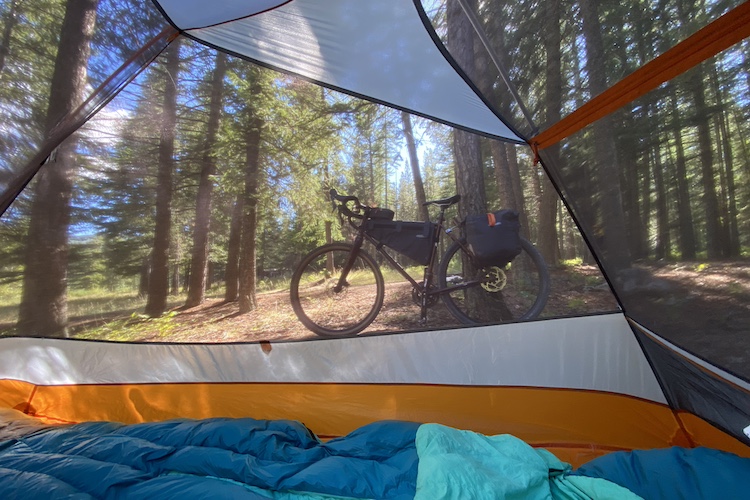
Clothes
This category is where I find most folks overestimate what they need, myself included. The more that you can stick to the necessities, the easier it is to stay organized and save weight.
Two or three sets of biking clothes should be sufficient to get you through your trip. If laundry isn’t available, you can hand wash the essential items like bike shorts. While you may eventually find that you like different bike clothes for touring versus day rides, you can absolutely use your everyday kit for your first tour. Then you can layer things like arm warmers, leg warmers, a windbreaker, etc.
You’ll want some off-bike clothes, but keep in mind that you may only wear them for the short time between arriving at camp and getting in your sleeping bag. One pair of pants and two shirts should easily get you through a week-long trip. Lastly, you’ll need something to sleep in. Everyone’s different, but I’ve found that a lightweight pair of stretchy pants and a short or long-sleeve t-shirt are perfect. If it’s chilly, these can even be layered underneath your off-bike clothes for extra warmth. A fleece or puffy jacket can be an additional layer for biking, camping, and even sleeping.
I would be remiss if I didn’t mention rain gear. This can be as simple as the same technical rain jacket that you already own, or you can invest in bike-specific jackets, pants, gloves, socks, and shoe covers. While it’s not absolutely essential to stay dry, being dry and cold can become a safety issue. The nice thing is that your on-bike rain gear can be your off-bike rain gear, too.
Food
Now for a popular topic. While it’s possible to feed yourself without heating anything up, most folks like a hot meal at the end of the day and/or coffee in the morning. There are tons of options for camp stoves and cooking gear, but this is an area where you can start with something basic and upgrade later. Or never. For $20 to $30, you can get a small stove that attaches to a pre-filled gas canister. Add a small aluminum pot for boiling water for coffee and freeze-dried meals, and you’re good to go.
I recommend not getting caught up in your cooking gear’s weight right away. Your bowl can even be as simple as a Tupperware container. Just make sure you have a way to keep your food separate from the rest of your kit, such as a waterproof stuff sack. And if you are in bear country, you will absolutely need a bear canister or a hang sack to keep your food safely away from camp. Heck, in most camping spots you’ll want one anyway to keep your nosh safe from other, less scary critters.
Other Stuff
In addition to your sleep system, clothing, and food, you’ll want some tools for common bike repairs, a basic first aid kit, and a headlamp. Other items to consider are a power bank and perhaps a very portable camp chair. Whatever you bring, ideally you will want it to be either multiple-purpose or used frequently. So, try to limit those luxury items that you may like to have but don’t need to have.
Carrying It All
This is where you are likely to make a specific bikepacking or bike touring investment. There are lots of options, but a traditional touring set-up of front and rear panniers is a good bet for road tours. The other main option is using a frame pack, seat bag, handlebar bag, and even some fork bag. The latter system is preferred by bikepackers because it is more secure and rattles less off-road. Bike shops that carry bike touring equipment aren’t always easy to find, but the increasing popularity of bike travel has helped. Shops near popular routes like the C&O, GAP, Katy Trail, GDMBR, and others are more likely to have options for outfitting your bike if you prefer to shop in person.
Final Advice
Don’t wait for your bike touring kit to be perfect before you embark on your adventure. You can make a lot of non-bike touring gear work, and learning what you don’t like before you buy can save time and money. One of the many reasons I love Adventure Cycling is that in addition to its self-contained tours, both the van supported and fully supported tours are camping-based. You can pack with less efficiency and have one of our vehicles transport your gear instead. This gives you more practice and flexibility to figure out and fine-tune your self-supported setup. The options abound, and I see some excellent camping nights in your future. Happy pedaling!
The post Ask an Adventure Cycling Tour Leader: What Gear Do I Need for a Week-long Tour as a Newbie? appeared first on Adventure Cycling Association.

